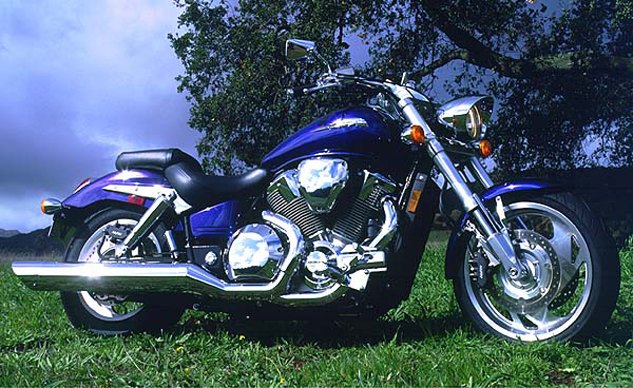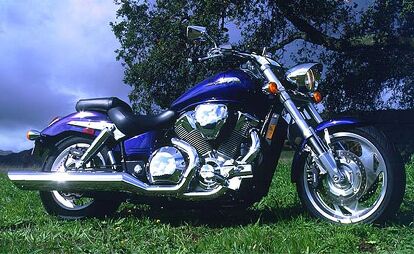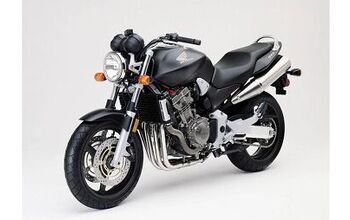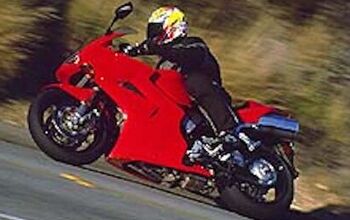Church Of MO – 2002 Honda VTX1800

If any category of motorcycling best represents the all-American “bigger is better” mentality, the cruiser segment is it. For 2002, Honda took this theme to heart with the introduction of the VTX1800, and for this week’s Church feature we travel back 13 years and revisit the 1800’s press intro in Santa Barbara, California. With a V-Twin engine so large, it was no surprise the central talking point revolved around it. That said, in typical Honda fashion, the rest of the machine received considerable thought as well. Read on to see just how the 2002 MO crew got on with Honda’s big, bad cruiser.
2002 Honda VTX1800
Santa Barbara, California, February 28, 2000 — Back in the seventies, motorcycles were evolving at an unprecedented rate. Motors got faster and suspension technology was making leaps ahead every year. Street bikes got bigger motors that overpowered the chassis they called home and brakes were horribly inefficient. Even on motocross bikes, twin shocks were replaced by mono-shocks that soon started working through linkages to get different ratios and increase wheel travel.
Soon, suspension travel exceeded 12 and even 13 inches, until people started to realize that maybe there is too much of a good thing, after all.Could this be deja’ vu all over again with Honda’s latest big-bore cruiser, the VTX 1800? In a word: No! Bigger, in this case at least, is better.
In an attempt to capitalize on the fastest-growing segment of our sport, cruisers have become a primary focus for many manufacturers, both Japanese and, of course, American. And while some choose styling over substance (read: performance) Honda has done their best to give us what they feel is a bike complete with “forward-looking” style and a motor that’s unlike anything ever fitted to a cruiser before. Even the exhaust valves are larger than on a P-51 mustang!
We recently trekked to the coastal town of Santa Barbara for the press introduction of Honda’s latest and greatest. In between spouts of rain, we were able to spend some saddle time on what Honda feels will be the bike that has the chests of Red Riders everywhere swelling with pride, and the bike that steals quite a few sales away from those “other” cruisers that, some say, are still stuck in the past.
Tech Briefing
Traditionally, Honda’s cruiser line-up has been varied, yet comfortable and reassuring — nothing fancy and certainly not anything risky. So what happens when Honda engineers are given a clean sheet of paper to scribble and doodle on? You get the VTX, that’s what. Equipped with a rubber-mounted, 1,795 cubic centimeter, 52-degree, fuel-injected V-twin engine, the VTX is unlike any other cruiser in the Honda line-up.
The concept of the VTX started as early as 1995, although the actual design process began in 1996. Honda designers were given a clean sheet of paper to design the nastiest and gnarliest machine around. Of course, a product of that nature doesn’t just pop into a person’s mind. Usually, inspiration is required and in this case, it came in the form of a 1995 concept bike, the Zodia, that made its rounds throughout the world as a well-received motorcycle show spectacle. Long and low with inverted forks, dual-chromed shocks and sleek chrome-hooded headlight, the VTX designers make no bones about what bike they drew inspiration from.
The engine features the largest connecting rods and cylinders (a whopping 4-inch diameter, in fact, just like a 400 Chevy!) ever made in a Honda facility, and this includes both cars and bikes. It goes without saying that a twin-cylinder machine with such large displacement would produce a prodigious amount of vibrations. To quell the wild animal within,Hondaneers outfitted the VTX with a 41.4 pound, offset dual-pin crankshaft. A titanic first impression, for sure, but it’s still got a narrow girth: By using two bolt-on balance weights, they saved 8.8 pounds and reduced crankcase width by nearly two inches versus producing a one-piece item.
Moving to the cylinder heads, you’ll notice the traditional Honda dual-plug, three-valve cylinder head design (two intake, one exhaust). The difference between this and other Hondas, though, is the immense girth of the various parts. For example, two 36mm intake valves feed the 101mm bore (that’s 3.97 inches) and 112 mm stroke (4.41 inches) mill. Think thats big? How does a 45mm exhaust valve sound? Just for reference, the diameter of the fork legs on the VTX are also 45mm. But even with such gargantuan valves, Honda still incorporated simple screw-and-locknut valve adjusters to keep maintenance a do-it-yourself affair.
Air makes its way into the cavernous cylinders by way of dual 42mm throttle bodies. Fuel, pressurized to 50 psi, is injected via dual injectors featuring 12 orifices for more efficient atomization — a first on a production vehicle. All of this is controlled by 3-D fuel-injection and ignition maps for each cylinder. Due to Honda’s diligence and the use of a closed-loop emission control system, the California version of the VTX meets all CARB Tier 2 (2008) standards, losing only one horsepower in the process. Also, the 49-state version exceeds the CARB Tier 1 (2004) level.
After ignition, exhaust gasses are swept out by a two-into-one exhaust that has to be the most obscene phallic symbol ever fitted to a production motorcycle. In other words, we like it. During the prototype phase, the engine would create such significant “power-pulses” that the exhaust shook a tremendous amount. This vibration was remedied, of course, as were the shakes that crept into the head-lamp and gas tank in pre-production models.
While the exhaust gasses may have a free path to escape, power is harnessed by an eight-plate clutch and five-speed gearbox. A shaft takes power to the rear wheel since the motor simply produces too much torque for any sort of belt-drive system currently available.
In order to slow all 705 pounds (claimed dry weight), the VTX features a unique version of their Linked Braking System. Instead of having all the brakes linked together in typical fashion, the VTX has independent front brake control, with the rear brake activating both front and rear calipers. However, the rear brake will only actuate the center of three pistons on the front caliper in conjunction with both rear brake pistons.
Activating the front brake will actuate the outer two pistons of each caliper. Honda did this since, they claim, cruiser riders tend to use their rear brake more frequently than the front binders. By using a variation of their LBS system, they are able to provide solid, balanced stopping power for those who only brake-dance with their feet, without intruding on “normal” brakers too much.
Potatoes, Potatoes
The morning started out with the sort of coastal beauty that makes you want to live in a beach town. The sun was peaking through broken clouds after a rain storm had passed, leaving the day’s ride a frigid but beautiful affair. The motors on the assembled VTXs were brought to life and you’d swear there was a bit of thunder rolling in the distance once again. At idle, you can count the RPMs and feel the explosion of each stroke even as you approach the bike.
Pulling away, the first thing we noticed was why Doug Toland spent so much time on the VTX’s “power-pulses” the previous night. Each and every time a piston rises and falls, you feel it. Not in your hands, but in your heart. It’s the sort of muted violence that can make you smile or cringe, depending on your perspective on life. The best analogy we can come up with? Hold a mattress vertically and have Johnson throw bricks at you. That’s what the VTX feels like: You feel the sharp crack, the severity of every action, and thank your favorite deity that there’s something between that source and you.
Exiting the hotel parking lot, heading out onto the street, a quick braaap of the throttle revealed two things: lots of power and, not as pleasingly, we also detected a fair amount of driveline lash.
Cracking open the throttle at even 10 miles-per-hour produces serious thrust, the likes of which have only been found on seriously modified cruisers until this point. However, somewhere between the crankshaft and the rear wheel reside no less than four dampeners that keep power-pulses to acceptable levels. They do a good job, no doubt, as the solid-mounted handlebars transmit very little of the motor’s vibes to the rider.
Still, the trade-off is that, with all of that “cush” in the driveline, there’s some slack to be taken up every time you twist the throttle. At low revs, for instance, opening the throttle from fully-closed causes the engine’s revs to start picking up ever so slightly before the rear wheel starts putting some of that force to the rear rubber. At that point, there is a bit of a jerk as the driveline catches up and starts producing serious forward thrust. Our advice: Be smooth, don’t wack the throttle, and you’ll be fine.
Our other gripes? The clutch and brake levers should be adjustable, just as many other Honda bikes are. With a motor that appeals to big people, and a seat height that appeals to smaller people, there will be some variance in the size of their hands. Why not make concessions for this? Also, though the brakes are decent for a cruiser, why not just go ahead and make them truly great?
Double discs and six-pot calipers should provide far more feel and initial bite than the VTX’s binders allow.Minor nuisances aside, the VTX is quite simply the most powerful stock cruiser we’ve ever ridden. Every time we’d have occasion to twist the throttle, it was open wide and the resulting power would surprise us every time. Hey, maybe there is a reason for this 150 mph-speedometer after all.
Doug Toland told us at dinner about spending hours at a time burning through tanks of fuel on this bike, tapped out in top gear with his head down and feet up on the Honda Proving Center of California track that features a 7.5 mile oval. His hot tips for top speed? Tucking in gets you a few miles an hour. Likewise, taking your feet off the forward-mounted pegs and letting them be held up by the wind, behind the bike’s mid-line, counted for a few more miles an hour on top as well. With the reduced wind-resistance the bike was able to reach the rev-limiter (fuel cut-off, not skip-spark) in top gear for long stints in excess of an indicated 140 miles per hour.
When not performing Rollie Free-style antics on closed courses, the ergonomics on the VTX seem well-suited for a wide range of riders. The low seat height is an open door for those shorties amognst us, while the long reach to the bars and forward-mounted foot pegs allow room for just about anybody this side of Shaq.
At 6’2″ tall, Minime’s knees were bent at just more than 90-degrees and he wished for peg mounting that afforded just a bit more leg room. The flip side to his ganglyness is that he overheard some shorter riders saying they wished the pegs were mounted even closer. What this means, we guess, it that Honda has found a nice middle-ground here and that people who buy this bike will not be put off by a riding position that’s either too spread out or too cramped.
The motor that allows such high terminal velocities is equally adept at everything from parking lot profiling to open-highway cruising. The power-pulses are big – nay, huge – but they’re never intrusive in the way that yearly doctor’s exams tend to be. This motor provides more of a constant remainder as to what’s going on internally, with a nice consistent pat on the butt instead of a jarring feeling deep inside you.
The vibes start out thick and, as the revs climb, things get very smooth (for a V-twin) and purr right until it’s time to shift. Power never falls off on top, instead it keeps climbing until you up-shift or hit the fuel cut-off that acts as a soft rev-limiter.
In the mid-range, where this bike will spend most of its time, the response from the motor is extremely impressive. On most cruisers the throttle is more of a binary device, either open or closed. On the VTX, however, we actually had to modulate the throttle thanks to the copious power flowing from the big cylinders beneath us. This is not to say that the VTX is hard to ride, however, because it is obviously not. There were a few people on the intro that had never ridden anything this large or powerful before and they had no problem adapting to the 1800 beneath them.
Taking the Honda off its side-stand, you know it’s a BIG bike, though it hides its weight remarkably well once under way. Only in slow parking-lot maneuvers where you get (abnormally) out of shape would you be able to feel how substantial the machine truly is. The long and low styling also helps in keeping the center of gravity low and the bike manageable, even for those short of strength.
In the twisties, the chassis worked well and we were able to keep things pointed in the right direction. The suspension provides decent feedback and takes care of most road irregularities without much fuss. Still, the bike still has the sort of suspension that lets you know you’re on a cruiser. The front end doesn’t quite work in concert with the back end and there’s really no reason for this on any cruiser — especially one as well-developed as this VTX.
Ground-clearance is about average as far as cruisers go, though any sort of attempt at high cornering speeds will result in some hero-blob scrapes. We’re fine with this, though, as Honda pointed out that they made certain the first thing to drag was “soft” and would not cause damage to the bike or cause it to veer off line. It’s a nuisance at first and a comfort shortly thereafter. We found ourselves setting corner speed by how hard the pegs dug in and then adjusting that lean angle by varying the throttle.
Even when the bike was laid over hard, well past the point where things touched down, the chassis never became unsettled. Even at triple digits where this bike is not likely to spend much time, it stayed firmly planted to terra firma. It’s nice to know the capability is there should you decide to call on it, and this speaks highly of the amount of attention Honda’s engineers paid to every detail of the bike.
Conclusion
Whether or not Honda did go overboard with two 900cc cylinders bolted to a single crank, separated by only 52-degrees, will be decided by market demand, but as far as we’re concerned, they did things just right.
Sure, the power pulses are fantastic and there’s something serious going on in the combustion chambers below the frame’s main spar, but the real magic is not in how physically big the various bits are — what’s most impressive is how well the whole package works together, especially considering this is a brand new motorcycle. Often, when a manufacturer puts together something that’s aimed at being the biggest, baddest something-or-other that has ever existed, they end up getting a big, bad pile. That is most certainly not the case for the VTX 1800.
From inception to execution, it looks like the Honda boys have been right on target. A few niggles aside, they have made what is — for now at least — the most impressive cruiser we’ve yet to throw a leg over.
Specifications
Price ,499 USDollarsEngine 1795cc liquid-cooled 52-degree V-twinBore and Stroke 101.0mm x 112.0mmCompression Ratio 9.0:1Valve Train SOHC; three valves per cylinderCarburetion PGM-FI with automatic chokeIgnition Solid-state digital, 2 spark plugs per cylinderTransmission Five-speedFinal Drive ShaftSuspension Front: 45mm inverted fork; 4.3 inches travelRear: Dual shocks with 5-position spring preload adjustability; 3.9 inches travelBrakes Front: Dual 296mm disc with LBS 3-piston calipersRear: Single 316mm disc with LBS 2-piston caliperTires Front: 130/70R-18 radialRear: 180/70R-16 radialWheelbase 67.5 inchesRake (Caster Angle) 32.0 degreesTrail 146mm (5.8 inches)Seat Height 27.3 inchesDry Weight 705 poundsFuel Capacity 4.5 gallonsColors Illusion Red, Illusion Blue, Metallic Silver, Black

Troy's been riding motorcycles and writing about them since 2006, getting his start at Rider Magazine. From there, he moved to Sport Rider Magazine before finally landing at Motorcycle.com in 2011. A lifelong gearhead who didn't fully immerse himself in motorcycles until his teenage years, Troy's interests have always been in technology, performance, and going fast. Naturally, racing was the perfect avenue to combine all three. Troy has been racing nearly as long as he's been riding and has competed at the AMA national level. He's also won multiple club races throughout the country, culminating in a Utah Sport Bike Association championship in 2011. He has been invited as a guest instructor for the Yamaha Champions Riding School, and when he's not out riding, he's either wrenching on bikes or watching MotoGP.
More by Troy Siahaan













































Comments
Join the conversation
With mild turning, these bikes make over 90 hp and 100 ft lbs. One can buy clean ones used all day long for 6 grand or less. They are also unbreakably reliable.
Gargantuan heavy beasts they are, but the wind is not gonna push the big 1800 around, the inverted forks are nicely rigid and they make a nice substantial feeling over the road bike when set up for touring. I bummed a ride on a VTX and was quite impressed by it. The motor is thumpity thump hand of God stuff, the chassis felt heavy and secure. Ironically, the Harleys I have ridden felt much smaller, tamer, and easier to manage. The heavy and fast VTX definitely feels like it could get it's rider in trouble. I kinda like that about it.
Alas, the VTX is not the "genuine" 65 hp air cooled pushrod equipped article, so comparatively not that many were sold. A great used bike buy then for the value minded shopper who wants a serious hunk of cruiser metal and does not feel compelled to join the me too club.